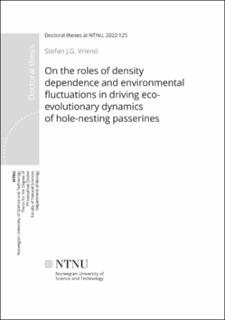| dc.contributor.advisor | Sæther, Bernt-Erik | |
| dc.contributor.advisor | Grøtan, Vidar | |
| dc.contributor.advisor | Gamelon, Marlène | |
| dc.contributor.author | Vriend, Stefan J.G | |
| dc.date.accessioned | 2022-04-22T13:07:47Z | |
| dc.date.available | 2022-04-22T13:07:47Z | |
| dc.date.issued | 2022 | |
| dc.identifier.isbn | 978-82-326-6318-7 | |
| dc.identifier.issn | 2703-8084 | |
| dc.identifier.uri | https://hdl.handle.net/11250/2992325 | |
| dc.description.abstract | Ecology and evolution are intrinsically linked through an inevitable struggle for existence. This has been appreciated over very long timescales, such as the adaptation of organisms to the diverse environments across the world. Following the revelation that evolution may act on contemporary timescales, researchers realised that ecological and evolutionary processes may interact (i.e., eco-evolutionary dynamics) or feedback into each other (i.e., eco-evolutionary feedback loops) on much shorter timescales as well.
In their struggle for existence, individuals face multiple challenges. Two challenges that have received considerable attention because of their roles in ecological and evolutionary processes of many natural systems are competition and the resulting density dependence (i.e., reduced population growth and underlying vital rates as populations reach high densities), and stochastic environmental fluctuations. Nonetheless, there is still much to learn about how density dependence and environmental fluctuations shape ecological and evolutionary processes.
Fundamental to this thesis are the long-term, individual-based data from an extensive collection of secondary hole-nesting bird populations across Europe. Hole-nesting birds readily breed in nest boxes, which allows individual birds to be systematically monitored throughout their lives, generating a gold mine for studies on eco-evolutionary dynamics. Using data from various sets of populations and species I studied the impacts of density dependence, both within populations and between populations of different species, on phenotypic selection and population dynamics, and of environmental variability on phenotypic selection and spatial trait synchrony (i.e., correlated fluctuations of trait values across spatially distinct populations). I found that:
In collared flycatchers (Ficedula albicollis), laying date and fledgling number are subject to density-dependent selection, which can be considered the simplest form of an eco-evolutionary feedback loop; that is, at small populations sizes, individuals were favoured with trait values (e.g., more fledglings) that promote population growth, which, in turn, will select for individuals that deal well with large population sizes.
Blue tits (Cyanistes caeruleus) are more negatively affected by interspecific competition (i.e., interspecific density dependence) than great tits (Parus major), a competitive asymmetry that has previously been demonstrated between these species. We found no consistent evidence, however, of intra- and interspecific density-dependent selection on fitness-related traits.
Environmental stochasticity may impact the fitnesses of individual collared flycatchers differently depending on their traits (e.g., clutch size or fledgling number) as well as the mean trait and size of the population.
Spatially correlated fluctuations of environmental variables, such as temperature, may induce large-scale spatiotemporal correlations in the values of fitness-related traits, such as laying date, particularly in the resident blue tit and great tit and less so in the migratory pied flycatcher (Ficedula hypoleuca).
This thesis illustrated that intraspecific density dependence, interspecific density dependence, and environmental stochasticity constitute three paths through which ecology and evolution may be impacted and intertwined. Yet, the large heterogeneity among populations and study sites in the strength and direction of some effects suggests that the outcome of eco-evolutionary dynamics is dependent on the trait, population, species and system under study. | en_US |
| dc.language.iso | eng | en_US |
| dc.publisher | NTNU | en_US |
| dc.relation.ispartofseries | Doctoral theses at NTNU;2022:125 | |
| dc.relation.haspart | Paper 1: Sæther, Bernt-Erik; Engen, Steinar; Gustafsson, Lars; Grøtan, Vidar; Vriend, Stefan. Density-Dependent Adaptive Topography in a Small Passerine Bird, the Collared Flycatcher. The American Naturalist 2020 ;Volum 197.(1) s. 93-110 https://doi.org/10.1086/711752 | en_US |
| dc.relation.haspart | Paper 2:
Vriend S.J.G., Engen S., Gustafsson L., Sæther B.-E., and Grøtan V.
The effect of stochastic environmental fluctuations on phenotypic selection: a feedback loop between ecology and evolution | en_US |
| dc.relation.haspart | Paper 3: Gamelon, Marlène; Vriend, Stefan; Engen, Steinar; Adriaensen, Frank; Dhondt, A.A.; Evans, Simon R.; Matthysen, Erik; Sheldon, Ben C.; Sæther, Bernt-Erik. Accounting for interspecific competition and age structure in demographic analyses of density dependence improves predictions of fluctuations in population size. Ecology Letters 2019 ;Volum 22. s. 797-806 https://doi.org/10.1111/ele.13237 | en_US |
| dc.relation.haspart | Paper 4:
Vriend S.J.G., Gamelon M., Adriaensen F., Cole E.F., Dhondt A.A., Matthysen E., Orell M.,
Rytkönen S., Sheldon B.C., Vatka E., Visser M.E., and Sæther B.-E.
The contribution of intra- and interspecific competition to phenotypic selection on fitness-related traits: a comparative study in hole-nesting passerines | en_US |
| dc.relation.haspart | Paper 5:
Vriend S.J.G., Grøtan V., Gamelon M., Adriaensen F., Ahola M.P., Álvarez E., Bailey L.D.,
Barba E., Bouvier J.-C., Burgess M.D., Bushuev A., Camacho C., Canal D., Charmantier A.,
Cole E.F., Cusimano C., Doligez B.F., Drobniak S.M., Dubiec A., Eens M., Eeva T., Erikstad
K.E., Ferns P.N., Goodenough A.E., Hartley I.R., Hinsley S.A., Ivankina E., Juškaitis R.,
Kempenaers B., Kerimov A.B., Kålås J.A., Lavigne C., Leivits A., Mainwaring M.C.,
Martínez-Padilla J., Matthysen E., van Oers K., Orell M., Pinxten R., Reiertsen T.K.,
Rytkönen S., Senar J.C., Sheldon B.C., Sorace A., Török J., Vatka E., Visser M.E., and
Sæther B.-E.
Temperature synchronizes temporal variation in laying dates across European hole-nesting passerines | en_US |
| dc.title | On the roles of density dependence and environmental fluctuations in driving ecoevolutionary dynamics of hole-nesting passerines | en_US |
| dc.type | Doctoral thesis | en_US |
| dc.subject.nsi | VDP::Mathematics and natural science: 400::Basic biosciences: 470 | en_US |

